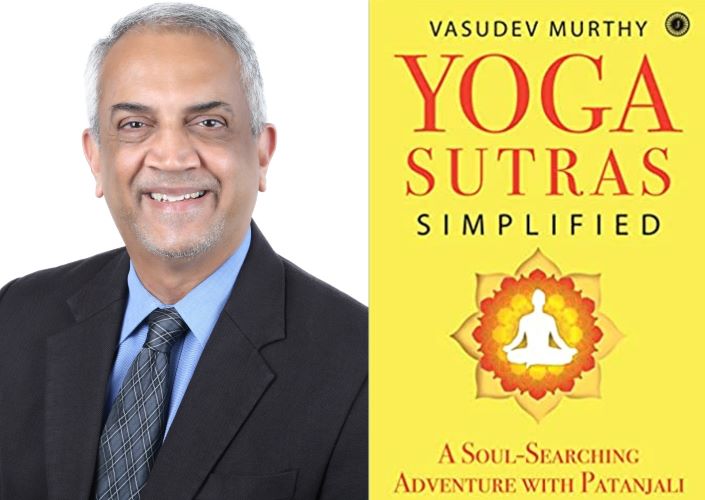‘Yoga Sutras’ expounds the meaning of Yoga and its purpose in our life

Author Vasudev Murthy and his book Yoga Sutras
Team L&M
Yoga has been used for millennia as a tool for self-discovery and illumination, with the ultimate goal of uniting the individual consciousness with the universal. Time and again scholars as also new initiates into this wonderful human science have written books expounding the benefits of Yoga. The recently-released Yoga Sutra Simplified – A Searching Adventure With Patanjali (Jaico Books) is a new book in this series. Written by author-musician-yoga practitioner Vasudev Murthy, the book expounds the purpose and meaning of yoga, going beyond the popular physical aspects. The author has also shared the steps we need to master to gain more control over our mind and in turn, our daily life.
Following is an extract from the book Page 92-94
The Destruction of His Ego
Patanjali, in the 18th sutra, lays out a detailed and fascinating exposition of how the gunas receive sustenance. Why do these three qualities of the human psyche behave in the way they do?
Paraphrasing from Edwin Bryant’s remarkable commentary on the Yogasutras:
“The five elements that absorb knowledge: ears, eyes, skin, tongue and nose—and the five organs that connote action (the tongue, hands, feet and the excretory and reproductive organs)—and the responsive mind—are the manifestations of the ego, and continuously work on the mind that is yet unable to discriminate between what is real and what is not.”
Put together, we see that the forces that continuously juggle the gunas refuse to distinguish between the seer (pure, unchanging consciousness) and the seen (always changing and temporary).
The seer witnesses the fluctuating mind as it responds to stimuli through the layer of intelligence.
The seen exists only for the sake of the seer.
This is a very profound statement.
By itself, that which is seen is not aware of itself.
Pain does not know pain. Pleasure does not know pleasure. The experience is that of the seer, who must learn to dissolve the seen.
And to repeat in a separate way what was stated earlier:
For the liberated, the seen disappears.
For the non-liberated, the seen persists.
Isn’t that beautiful?
We then refer to the possibility of a multiplicity of the seers (referred to as purushas), some who no longer engage with the previously seen, knowing it is illusory and others (non-liberated purushas) who continue to believe in the distinction.
Patanjali expands on the nature of the relationship between the seer and the seen. Purusha, pure consciousness, possesses the external world, prakriti, in all its dimensions.
Prakritiis unmasked as being nothing but a facilitating instrument for purusha. Till the state of discernment is not reached, we exist in a state of ignorance, further feeding the other gunas. That ignorance is also rooted in samskaras—latent impressions of existence. And yet, as was discussed in the Samadhi Pada, true liberation happens when intelligence ceases to function once ignorance is erased.
And that is how the seer is truly freed!
The ability to erode ignorance needs time to hone. A lot of time. It requires deep focus and constant rejuvenation. It needs the competence to finely discriminate (viveka) nuances of the integrity of knowledge. This ability improves as one whittles further down, always choosing a finer path when presented with choices. But sustained efforts are necessary to distinguish between what is real and what is not.
At this point, Patanjali says that this relentlessly cultivated ability to discriminate brings us closer to true knowledge (samadhi) in its purest form. It is seen in seven (progressive) steps. Specifically, integration with the body, the senses, life energy, the mind, the intellect, consciousness and the soul.
Through sincere dedication to the practice of these seven steps of yoga, each of which serves a critical purpose, spiritual illumination is reached, which transcends bookish knowledge or the words of scholars.
These are the lessons I gleaned from sutras 15 through 28 of the Sadhana Pada:
The three gunas of sattva, rajas and tamas are in constant flux and act in concert. They ensure the continuance of suffering.
The “seen” exists solely for the “seer” to recognise his own true nature.
Spiritual enlightenment is achieved through the unceasing
pursuit of discrimination to isolate and erase ignorance.

